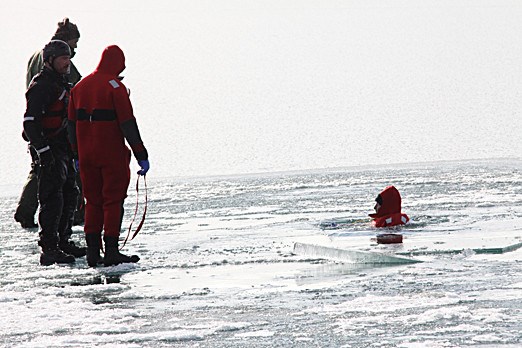Scott Ellery plunged through the ice and into the frigid waters of Lake Superior Wednesday.
Instead of panicking Ellery laughed as he treaded water. Twenty minutes after being rescued, he went through again.
He, along with 13 other people, attended the two-day ice-training course hosted by Raven Rescue. Participants spent a day in the classroom then moved onto the ice at Silver Habour Conservation Area the following day. The participants were placed into teams of two.
By Wednesday afternoon, most of the participants were laughing while in the cold waters.
"Being on the ice is kind of a funny term because we’ve been in the ice more than being on it," Ellery a Parks Superintendent with Ontario Parks, said after a session in the ice.
"We go on the ice in the winter time to get to places we otherwise couldn’t get to. We can obviously go by helicopter, floatplane and everything else. But winter time allows us the opportunity to go out by snowmobile."
Being a superintendent doesn’t allow him much time out of the office. He said the training helps to ensure that when he does go out he is prepared and can handle a situation on the ice safely.
"There have been situations where I have gone through the ice up to my waist," he said. "I can’t think of a worse way to go then going through the ice and drowning or dying from hypothermia.
“It’s not a pretty thing. With this training we have the tools to make sure we’re working in compliance with our policies as well as enjoying ourselves with our families or whether it’s playing shiny with our buddies."
Tim Wheeler, instructor with Raven Rescue, has taught the course for more than five years. When it comes to the ice, the important thing to know is how stable it is and not necessarily how thick it is, he said.
"Ice depends on wind conditions and even micro conditions," Wheeler said. "Maybe there is a biomass in the lake and that there are a lot more gas in that particular body of water and it might be weaker than other areas. You don’t want to think of thickness of ice. You want to think quality and bulk of ice."
Wheeler focused the course on situations where participants had minimal gear and little resources to use. He outfitted each participant with a rope and a water noodle and then had them attempt to get themselves out of the ice safely.
At the beginning of the class, Wheeler asked the 14 participants if they had gone through the ice. Only two people said they hadn’t.
"They’re having a lot of fun," he said. "The ice conditions that we’re working with right now are creating some real life scenarios and the ice is changing while we’re out there."
Sign in or register
- Messages
- Post a Listing
- Your Listings
- Your Profile
- Your Subscriptions
- Your Likes
- Your Business
- Support Local News
- Payment History
Registered Users
Already have an account?
New Users
Create a free account.
